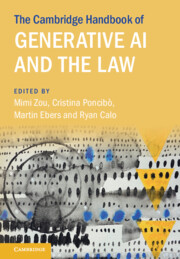Book contents
- The Cambridge Handbook of Generative AI and the Law
- The Cambridge Handbook of Generative AI and the Law
- Copyright page
- Contents
- Figures
- Tables
- List of Contributors
- Foreword
- Preface
- Part I Understanding Generative AI from Multidisciplinary Perspectives
- Part II Evolving Regulatory and Governance Frameworks
- Part III Generative AI
- 14 Generative AI and Non-discrimination Law in the EU
- 15 Generative AI and Data Protection
- 16 Generative AI and the Fundamental Limitations of US Privacy Law
- 17 Generative AI and IP Under US Law
- 18 Copyright and Generative AI in Japan and China
- 19 Redefining Rivalry
- 20 Regulating Hypersuasion
- 21 Generative AI Systems and Corporate Governance, Compliance and Liability
- 22 Generative AI and Criminal Guilt
- Part IV The Use of Generative AI in Legal and Related Sectors
22 - Generative AI and Criminal Guilt
When No One Meant to Harm
from Part III - Generative AI
Published online by Cambridge University Press: 08 August 2025
- The Cambridge Handbook of Generative AI and the Law
- The Cambridge Handbook of Generative AI and the Law
- Copyright page
- Contents
- Figures
- Tables
- List of Contributors
- Foreword
- Preface
- Part I Understanding Generative AI from Multidisciplinary Perspectives
- Part II Evolving Regulatory and Governance Frameworks
- Part III Generative AI
- 14 Generative AI and Non-discrimination Law in the EU
- 15 Generative AI and Data Protection
- 16 Generative AI and the Fundamental Limitations of US Privacy Law
- 17 Generative AI and IP Under US Law
- 18 Copyright and Generative AI in Japan and China
- 19 Redefining Rivalry
- 20 Regulating Hypersuasion
- 21 Generative AI Systems and Corporate Governance, Compliance and Liability
- 22 Generative AI and Criminal Guilt
- Part IV The Use of Generative AI in Legal and Related Sectors
Summary
Several criminal offences can originate from or culminate with the creation of content. Sexual abuse can be perpetrated by producing intimate material without the subject’s consent, while incitement to criminal activity can begin with a simple conversation. When the task of generating content is entrusted to artificial agents, it becomes necessary to delve into the associated risks posed by this technology. Generative AI changes criminal affordances because it simplifies access to harmful or dangerous content, amplifies the range of recipients, creates new kinds of harmful content, and can exploit cognitive vulnerabilities to manipulate user behaviour. Given this evolving landscape, the question that arises is whether criminal law should be involved in the policies aimed at fighting and preventing Generative AI-related harms. The bulk of criminal law scholarship to date would not criminalise AI harms on the theory that AI lacks moral agency. However, when a serious harm occurs, responsibility needs to be distributed considering the guilt of the agents involved, and, if it is lacking, it needs to fall back because of their innocence. Legal systems need to start exploring whether and how guilt can be preserved when the actus reus is completely or partially delegated to Generative AI.
Keywords
Information
- Type
- Chapter
- Information
- The Cambridge Handbook of Generative AI and the Law , pp. 392 - 404Publisher: Cambridge University PressPrint publication year: 2025
